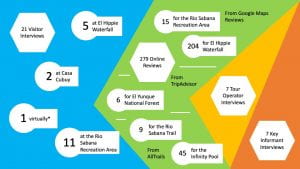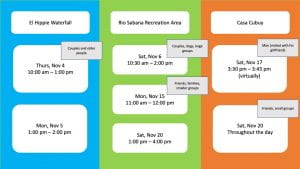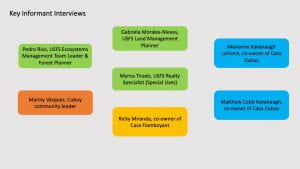Exploring Perspectives and Expectations of El Yunque National Forest Visitors
Project Sponsor: Pedro Rios, United States Forest Service (USFS) & Gabriela Morales-Nieves, USFS
Student Team: Chloe Byrne (Biochemistry ’23), Akhil Chilamkurthi (Biomedical Engineering ’23), Rachel Flanagan (Civil Engineering ’23), & Celeste Rehm (Actuarial Mathematics ’23)
Advisors: Professor Leslie Dodson & Professor Robert Hersh

Photo of the Rio Sabana Recreation Area, located in the southern region of El Yunque National Forest.
Abstract:
The Rio Sabana Recreation Area is located on the southern side of El Yunque National Forest in Puerto Rico. While visitor activity is well-documented on the northern side of El Yunque, much less is known about the experiences and motivations of visitors to the south. To bring the United States Forest Service and the local community of Cubuy a deeper understanding of visitors to the south, especially those who come to the Rio Sabana Recreation Area, the team examined online visitor reviews and conducted interviews with visitors, tour guides, and other key parties, and through analysis developed six typologies of visitors to the area. This report offers recommendations regarding increased signage and trail maintenance, sale of food and beverages, and solicitation of public attitudes.
Link to the full report (external website)
Download the full report (low image quality due to reduced file size)
Download the final presentation
Download deliverable (brochure)
Download deliverable (infographic)
Executive Summary:
El Yunque National Forest (ENYF), Puerto Rico’s only tropical rainforest, has long been utilized for its valuable resources and for various research and recreational purposes. It has been managed by the United States Forest Service (USFS) since 1903 (Rivera, 2021; McGinley 2017). The USFS manages national forests and grasslands throughout the United States and Puerto Rico (USDA, n.d.j). In 2012, the USFS began to develop a new management plan for El Yunque under the leadership of Pedro Rios, USFS Ecosystems Management and Forest Planning Team Leader, which was finalized in 2019. This plan promoted the shift from a top-down management approach to a more community-oriented one.
The new management approach resulted in several changes, including a recent proposal submitted to the USFS by the local community of Cubuy, Naguabo. The neighborhood of Cubuy would like to manage the Rio Sabana Recreation Area (the only recreation area in the southern region of El Yunque) as it would increase their opportunities for economic growth and engagement with visitors. As of December, 2021, the proposal has yet to be finalized, but a signed agreement is in the works (M. Vázquez, personal communication, October 28, 2021; Comité Pro Desarrollo, 2021).
El Yunque is a major attraction for visitors to Puerto Rico (M. Tirado, personal communication, December 2, 2021). Tourism to the forest is concentrated in the northern region, with comparably few tourists visiting the southern area. The USFS and local communities are aware that visitors come to the southern part of the forest, but are not clear about their motivations and expectations (M. Vazquez, personal communication, October 28, 2021). Visitor (or tourist) typologies are a way of categorizing visitors. They provide a way to do so more specifically than simply labeling visitors as “internal” and “domestic,” but broadly enough to allow one to make predictions or draw conclusions about behavior. They are not comprehensive, but they give management a way to segment the market in order to more effectively cater towards given types of visitors (Cochrane, 2006).
The goal of our project was to explore the perspectives and expectations of visitors to El Yunque National Forest in order to assist the USFS and local community in developing more comprehensive responses to visitors. To achieve this goal, we developed the following objectives:
- Explore perceptions of El Yunque National Forest visitors through social media
- Identify perspectives of tour operators to El Yunque and how they anticipate the needs of clients
- Compare perspectives of key informants, including USFS employees, community leaders, and business owners, about visitors to Cubuy, Naguabo
- Understand the motivations and experiences of visitors to Cubuy and the Rio Sabana Recreation Area and its associated trails

Figure 1. A graphic showing the number of interviews conducted and where, as well as the number of online reviews analyzed from which websites and for what locations.
To understand visitor motivations and perceptions, we gathered information from online review websites Google Maps Reviews, AllTrails, and TripAdvisor, and the social media platform Instagram (see Figure 1). We selected reviews for locations in addition to the recreation area to better understand the types of visitors that come to Cubuy, Naguabo. We also analyzed TripAdvisor reviews of nearby bed-and-breakfasts Casa Cubuy and Casa Flamboyant. We used frequency analysis and thematic content analysis to identify common themes, attitudes, and experiences from the reviews. We used frequency analysis to create word clouds to provide a visual representation of the most frequently expressed thoughts, concerns, and experiences. This helped us to form an outline for the questions we wanted to ask in visitor interviews and key informant interviews. We also used thematic content analysis to support these.
We interviewed seven tour company owners and guides. During these interviews, we asked tour operators about the tours they offered, their clients (including age range and other relevant information), and what they saw as the reasons visitors took their tours, as well as what they believed drew tourists to tours in general. We also asked if there were logistical differences between smaller or specialized tours and larger, more general tours. Finally, we asked about advantages or disadvantages and logistical considerations regarding tours in El Yunque, both as a whole and in the south specifically (for a full list of interview questions, see Appendix A of the full report). We analyzed these interviews using thematic content analysis to identify themes among tour operators.
To gain a more nuanced understanding of El Yunque visitors, we interviewed USFS employees, a prominent community leader, and local business owners about their perceptions of visitors to El Yunque (and to Cubuy, Naguabo in particular) (see Figure 2). We asked USFS employees questions regarding their perception of El Yunque tourism and about the permit system in El Yunque in order to get a better idea of how it influences tour operators and in turn visitors. We asked community leader Mariny Vázquez questions about her perception of tourists in the area, about the community proposal submitted to the USFS, and about her view of the relationships between the community and the USFS and the community and visitors to the area. On site visits, we asked local business owners questions relating to their clients, including how many visitors they received in a given time frame, what they perceived as their guests’ wants and needs, how they catered to those wants and needs, etc. (For complete lists of interview questions for USFS employees, business owners, and the community leader, please refer to Appendices B1, B2, and B3 of the final report, respectively.) We transcribed recorded interviews and analyzed them using thematic analysis in the same way as for the visitor interviews.
To explore the perspectives and expectations of visitors to Cubuy, Naguabo, we sought to address the following research questions: Who visits the Cubuy, Naguabo, area of El Yunque; why do they select this location; and what are their perceptions and expectations of the area? To answer these questions, we conducted semi-structured interviews with 21 El Yunque visitors (see Figure 1) and evaluated their responses through the lens of the Recreation Demand Hierarchy (adapted by McCool from Driver & Brown) and Cochrane’s tourist typologies, as discussed earlier.

Figure 3. A graphic showing the locations, dates, and times interviews were conducted. In the gray boxes are examples of the sorts of people encountered at that given location, day, and time.
To find visitors to interview, we first identified El Hippie Waterfall, the Rio Sabana Recreation Area, and the bed-and-breakfast Casa Cubuy, three locations within the southern region of El Yunque that were likely to attract visitors, and visited those areas over the course of five weeks (see Figure 3). We asked visitors questions such as where they were coming from, what they were expecting to see, whether this was their first time visiting El Yunque, etc. (for a complete list of visitor interview questions, please refer to Appendix C of the full report). We also conducted a virtual interview with a visitor who had stayed at Casa Cubuy and been to the Rio Sabana Recreation Area (see Figure 3).

Figure 5. The Recreation Demand Hierarchy (adapted from Driver & Brown by McCool): Activities, Settings, Benefits, Experiences (McCool, 2006).
To analyze our findings, we used the Recreation Demand Hierarchy (adapted from Driver & Brown by McCool) and Cochrane’s tourist typologies (see Figures 5 and 4, respectively). We found that there are competing ideas about the benefits of tourism to the area. While some feel that the Rio Sabana Recreation Area is unmaintained and that the hiking trails are unusable, others enjoy it for its hiking trails, the river, or the picnic pavilions. Some interviewees enjoy the area’s quiet, tranquil atmosphere and don’t want it changed, but others enjoy being able to socialize. We adapted Cochrane’s tourist typologies to help us identify different visitor inclinations among the people we interviewed (Figure 6). Our adapted typologies included the following visitor types: Exclusive, Tranquil, Social, Hiking, Hiking Plus, and Special Interest. This allowed us a somewhat broad categorization of visitors.

Figure 6. Typology of visitors to southern El Yunque National Forest, adapted from Cochrane’s International Typology of Tourists.
In order to gain a more nuanced understanding of individuals, we also created visitor profiles that are more in-depth than the typologies. We created five of these profiles across a range of visitor types.
Limitations of our research include the language barrier we sometimes encountered between us and the people with whom we interacted, where we conducted our research, time of day, days of week, and the time of year we were able to conduct research.
In conclusion, we recommend that the USFS add signs (both educational and directional) and increase trail maintenance. We also suggest that the sale of food and beverages at the Rio Sabana Recreation Area and in the Cubuy area would increase those locations’ attractiveness to visitors. We also offer recommendations for soliciting public attitudes: the gate at the entrance to the Rio Sabana Recreation Area path was an effective place to stop visitors and conduct interviews on their way out. It would also be beneficial to conduct interviews across a variety of days and times in order to get information for a wider range of visitors who come to the area than we were able to in our research.
Areas for future research include exploring appropriate entrepreneurial and tourism development opportunities connected to the Rio Sabana Recreation Area, and identifying sustainable and local business practices that could be applied to the Rio Sabana Recreation Area.

Photo of student group. Left to right: Chloe Byrne, Akhil Chilamkurthi, Celeste Rehm, Rachel Flanagan.

Photo of student group conducting an interview with community leader Mariny Vázquez, with Gabriela Morales-Nieves acting as translator. Left to right: Mariny, Gabriela, Rachel, Chloe, Celeste, Akhil.




